Customer Interaction and Nursing Reflective Model Application
VerifiedAdded on 2023/06/04
|10
|2762
|83
Essay
AI Summary
This essay delves into the critical aspects of customer interaction within healthcare, focusing on a consumer's narrative regarding their experience with prostate cancer. The assignment involves applying a nursing reflective model, specifically the Gibbs model, to analyze the consumer's story and extract valuable insights for professional development. The essay explores the importance of effective communication, empathy, and trust in healthcare settings, highlighting the significance of active listening, showing concern, and building rapport with patients. The student reflects on their feelings, thoughts, and judgments related to the consumer's narrative, identifying personal weaknesses and areas for improvement. The analysis includes an evaluation of the impact of the consumer's experience, a discussion of the role of awareness in healthcare, and the development of an action plan for future practice. The essay emphasizes the need for healthcare professionals to share experiences, create awareness, and handle clients with respect and compassion. References are provided in APA format, demonstrating a comprehensive understanding of the subject matter and the application of reflective practice in healthcare.
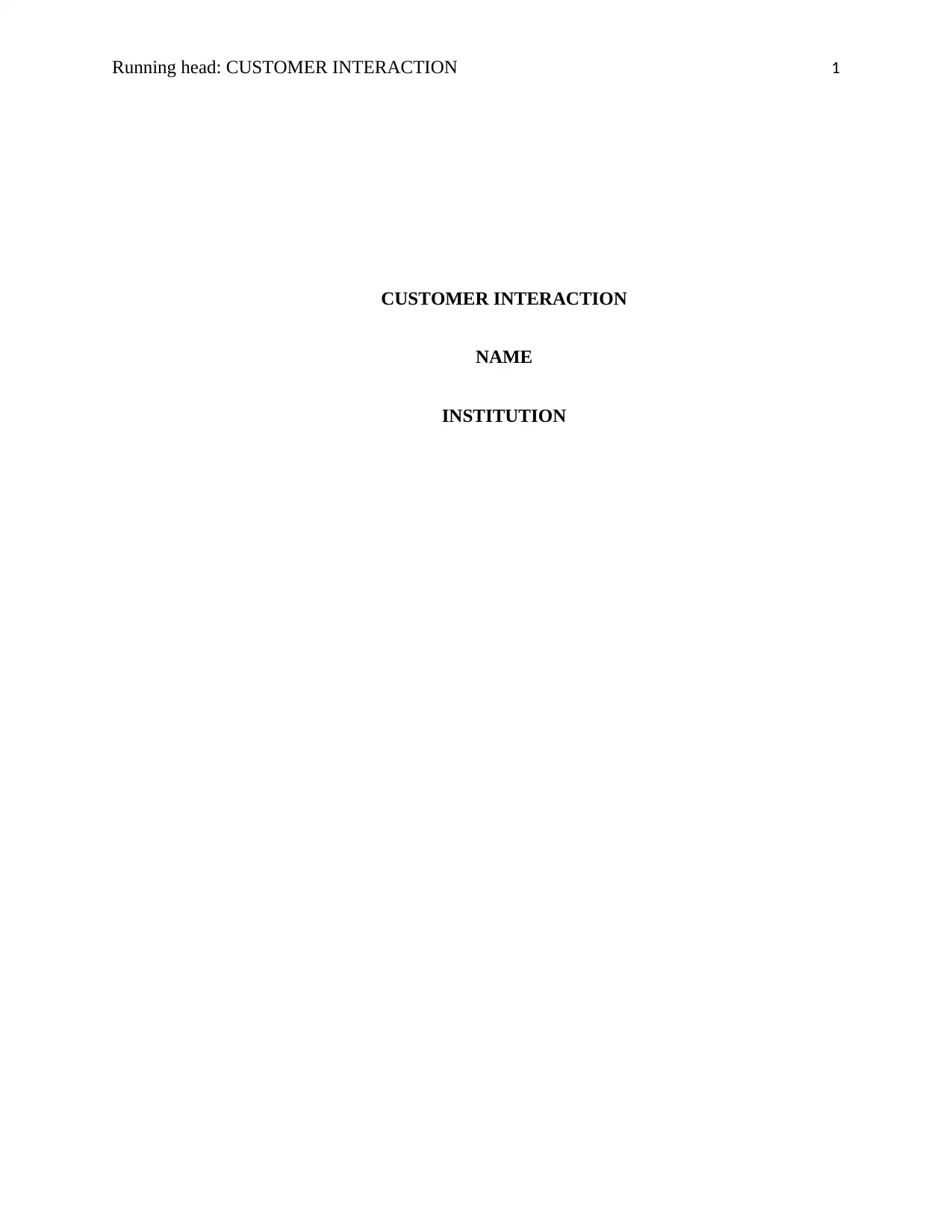
Running head: CUSTOMER INTERACTION 1
CUSTOMER INTERACTION
NAME
INSTITUTION
CUSTOMER INTERACTION
NAME
INSTITUTION
Paraphrase This Document
Need a fresh take? Get an instant paraphrase of this document with our AI Paraphraser
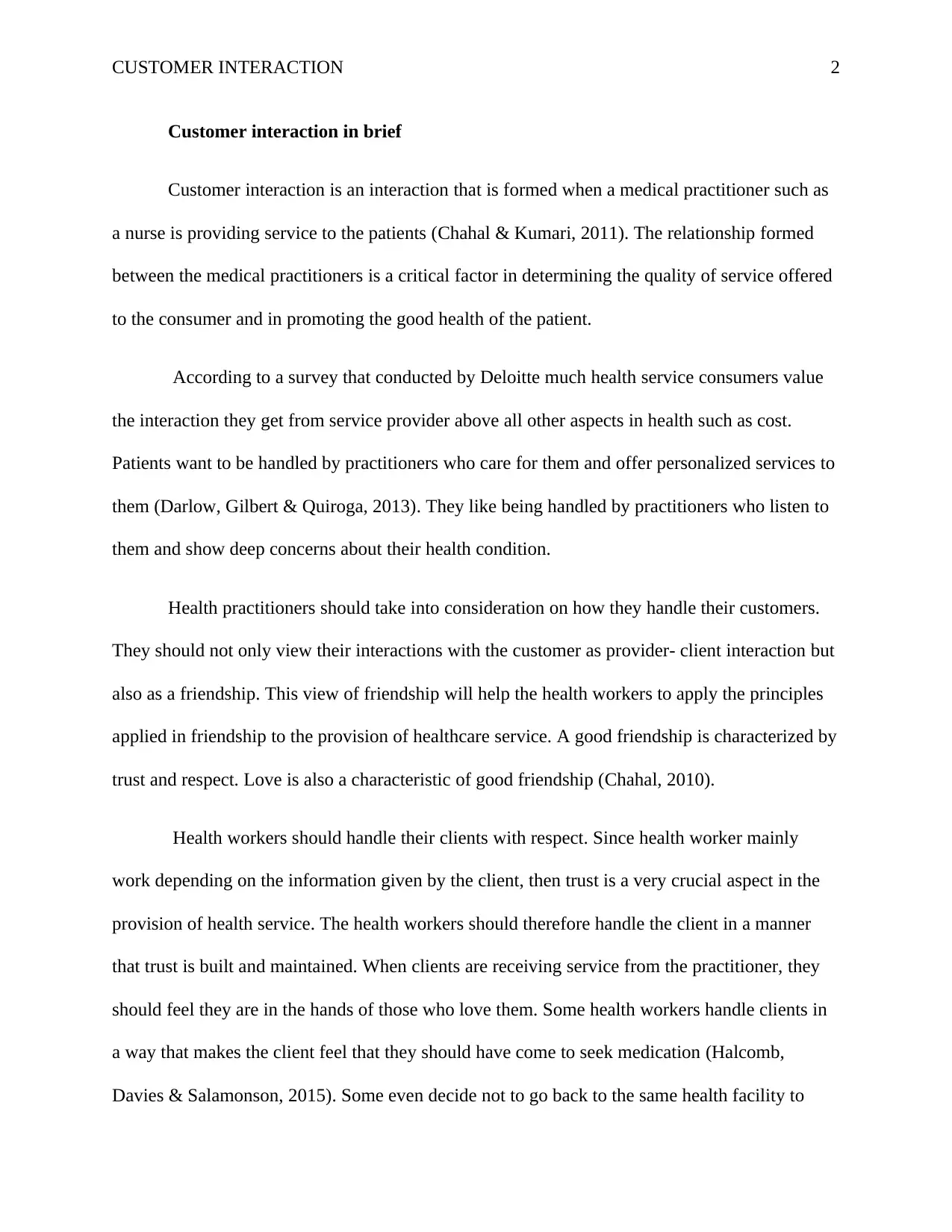
CUSTOMER INTERACTION 2
Customer interaction in brief
Customer interaction is an interaction that is formed when a medical practitioner such as
a nurse is providing service to the patients (Chahal & Kumari, 2011). The relationship formed
between the medical practitioners is a critical factor in determining the quality of service offered
to the consumer and in promoting the good health of the patient.
According to a survey that conducted by Deloitte much health service consumers value
the interaction they get from service provider above all other aspects in health such as cost.
Patients want to be handled by practitioners who care for them and offer personalized services to
them (Darlow, Gilbert & Quiroga, 2013). They like being handled by practitioners who listen to
them and show deep concerns about their health condition.
Health practitioners should take into consideration on how they handle their customers.
They should not only view their interactions with the customer as provider- client interaction but
also as a friendship. This view of friendship will help the health workers to apply the principles
applied in friendship to the provision of healthcare service. A good friendship is characterized by
trust and respect. Love is also a characteristic of good friendship (Chahal, 2010).
Health workers should handle their clients with respect. Since health worker mainly
work depending on the information given by the client, then trust is a very crucial aspect in the
provision of health service. The health workers should therefore handle the client in a manner
that trust is built and maintained. When clients are receiving service from the practitioner, they
should feel they are in the hands of those who love them. Some health workers handle clients in
a way that makes the client feel that they should have come to seek medication (Halcomb,
Davies & Salamonson, 2015). Some even decide not to go back to the same health facility to
Customer interaction in brief
Customer interaction is an interaction that is formed when a medical practitioner such as
a nurse is providing service to the patients (Chahal & Kumari, 2011). The relationship formed
between the medical practitioners is a critical factor in determining the quality of service offered
to the consumer and in promoting the good health of the patient.
According to a survey that conducted by Deloitte much health service consumers value
the interaction they get from service provider above all other aspects in health such as cost.
Patients want to be handled by practitioners who care for them and offer personalized services to
them (Darlow, Gilbert & Quiroga, 2013). They like being handled by practitioners who listen to
them and show deep concerns about their health condition.
Health practitioners should take into consideration on how they handle their customers.
They should not only view their interactions with the customer as provider- client interaction but
also as a friendship. This view of friendship will help the health workers to apply the principles
applied in friendship to the provision of healthcare service. A good friendship is characterized by
trust and respect. Love is also a characteristic of good friendship (Chahal, 2010).
Health workers should handle their clients with respect. Since health worker mainly
work depending on the information given by the client, then trust is a very crucial aspect in the
provision of health service. The health workers should therefore handle the client in a manner
that trust is built and maintained. When clients are receiving service from the practitioner, they
should feel they are in the hands of those who love them. Some health workers handle clients in
a way that makes the client feel that they should have come to seek medication (Halcomb,
Davies & Salamonson, 2015). Some even decide not to go back to the same health facility to
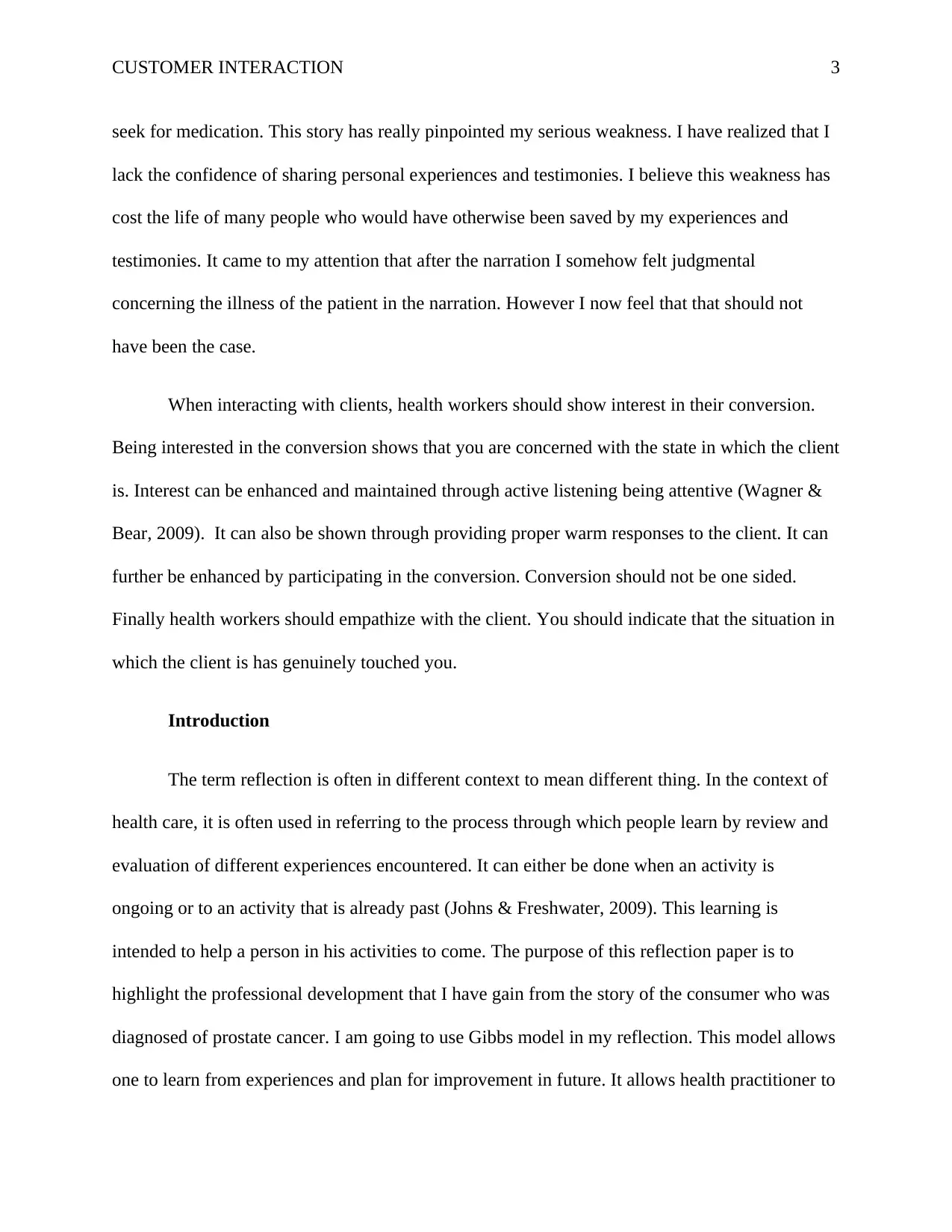
CUSTOMER INTERACTION 3
seek for medication. This story has really pinpointed my serious weakness. I have realized that I
lack the confidence of sharing personal experiences and testimonies. I believe this weakness has
cost the life of many people who would have otherwise been saved by my experiences and
testimonies. It came to my attention that after the narration I somehow felt judgmental
concerning the illness of the patient in the narration. However I now feel that that should not
have been the case.
When interacting with clients, health workers should show interest in their conversion.
Being interested in the conversion shows that you are concerned with the state in which the client
is. Interest can be enhanced and maintained through active listening being attentive (Wagner &
Bear, 2009). It can also be shown through providing proper warm responses to the client. It can
further be enhanced by participating in the conversion. Conversion should not be one sided.
Finally health workers should empathize with the client. You should indicate that the situation in
which the client is has genuinely touched you.
Introduction
The term reflection is often in different context to mean different thing. In the context of
health care, it is often used in referring to the process through which people learn by review and
evaluation of different experiences encountered. It can either be done when an activity is
ongoing or to an activity that is already past (Johns & Freshwater, 2009). This learning is
intended to help a person in his activities to come. The purpose of this reflection paper is to
highlight the professional development that I have gain from the story of the consumer who was
diagnosed of prostate cancer. I am going to use Gibbs model in my reflection. This model allows
one to learn from experiences and plan for improvement in future. It allows health practitioner to
seek for medication. This story has really pinpointed my serious weakness. I have realized that I
lack the confidence of sharing personal experiences and testimonies. I believe this weakness has
cost the life of many people who would have otherwise been saved by my experiences and
testimonies. It came to my attention that after the narration I somehow felt judgmental
concerning the illness of the patient in the narration. However I now feel that that should not
have been the case.
When interacting with clients, health workers should show interest in their conversion.
Being interested in the conversion shows that you are concerned with the state in which the client
is. Interest can be enhanced and maintained through active listening being attentive (Wagner &
Bear, 2009). It can also be shown through providing proper warm responses to the client. It can
further be enhanced by participating in the conversion. Conversion should not be one sided.
Finally health workers should empathize with the client. You should indicate that the situation in
which the client is has genuinely touched you.
Introduction
The term reflection is often in different context to mean different thing. In the context of
health care, it is often used in referring to the process through which people learn by review and
evaluation of different experiences encountered. It can either be done when an activity is
ongoing or to an activity that is already past (Johns & Freshwater, 2009). This learning is
intended to help a person in his activities to come. The purpose of this reflection paper is to
highlight the professional development that I have gain from the story of the consumer who was
diagnosed of prostate cancer. I am going to use Gibbs model in my reflection. This model allows
one to learn from experiences and plan for improvement in future. It allows health practitioner to
⊘ This is a preview!⊘
Do you want full access?
Subscribe today to unlock all pages.

Trusted by 1+ million students worldwide
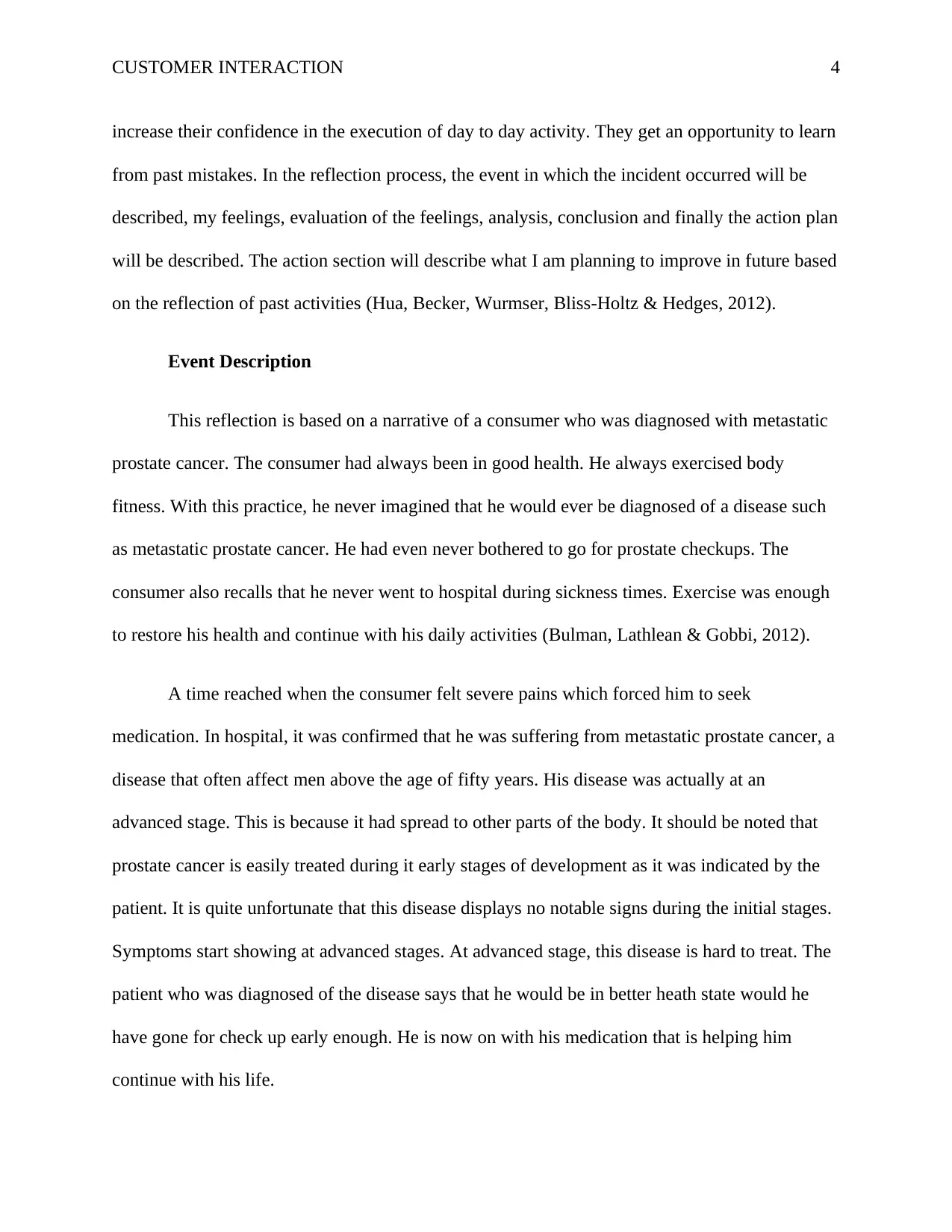
CUSTOMER INTERACTION 4
increase their confidence in the execution of day to day activity. They get an opportunity to learn
from past mistakes. In the reflection process, the event in which the incident occurred will be
described, my feelings, evaluation of the feelings, analysis, conclusion and finally the action plan
will be described. The action section will describe what I am planning to improve in future based
on the reflection of past activities (Hua, Becker, Wurmser, Bliss-Holtz & Hedges, 2012).
Event Description
This reflection is based on a narrative of a consumer who was diagnosed with metastatic
prostate cancer. The consumer had always been in good health. He always exercised body
fitness. With this practice, he never imagined that he would ever be diagnosed of a disease such
as metastatic prostate cancer. He had even never bothered to go for prostate checkups. The
consumer also recalls that he never went to hospital during sickness times. Exercise was enough
to restore his health and continue with his daily activities (Bulman, Lathlean & Gobbi, 2012).
A time reached when the consumer felt severe pains which forced him to seek
medication. In hospital, it was confirmed that he was suffering from metastatic prostate cancer, a
disease that often affect men above the age of fifty years. His disease was actually at an
advanced stage. This is because it had spread to other parts of the body. It should be noted that
prostate cancer is easily treated during it early stages of development as it was indicated by the
patient. It is quite unfortunate that this disease displays no notable signs during the initial stages.
Symptoms start showing at advanced stages. At advanced stage, this disease is hard to treat. The
patient who was diagnosed of the disease says that he would be in better heath state would he
have gone for check up early enough. He is now on with his medication that is helping him
continue with his life.
increase their confidence in the execution of day to day activity. They get an opportunity to learn
from past mistakes. In the reflection process, the event in which the incident occurred will be
described, my feelings, evaluation of the feelings, analysis, conclusion and finally the action plan
will be described. The action section will describe what I am planning to improve in future based
on the reflection of past activities (Hua, Becker, Wurmser, Bliss-Holtz & Hedges, 2012).
Event Description
This reflection is based on a narrative of a consumer who was diagnosed with metastatic
prostate cancer. The consumer had always been in good health. He always exercised body
fitness. With this practice, he never imagined that he would ever be diagnosed of a disease such
as metastatic prostate cancer. He had even never bothered to go for prostate checkups. The
consumer also recalls that he never went to hospital during sickness times. Exercise was enough
to restore his health and continue with his daily activities (Bulman, Lathlean & Gobbi, 2012).
A time reached when the consumer felt severe pains which forced him to seek
medication. In hospital, it was confirmed that he was suffering from metastatic prostate cancer, a
disease that often affect men above the age of fifty years. His disease was actually at an
advanced stage. This is because it had spread to other parts of the body. It should be noted that
prostate cancer is easily treated during it early stages of development as it was indicated by the
patient. It is quite unfortunate that this disease displays no notable signs during the initial stages.
Symptoms start showing at advanced stages. At advanced stage, this disease is hard to treat. The
patient who was diagnosed of the disease says that he would be in better heath state would he
have gone for check up early enough. He is now on with his medication that is helping him
continue with his life.
Paraphrase This Document
Need a fresh take? Get an instant paraphrase of this document with our AI Paraphraser
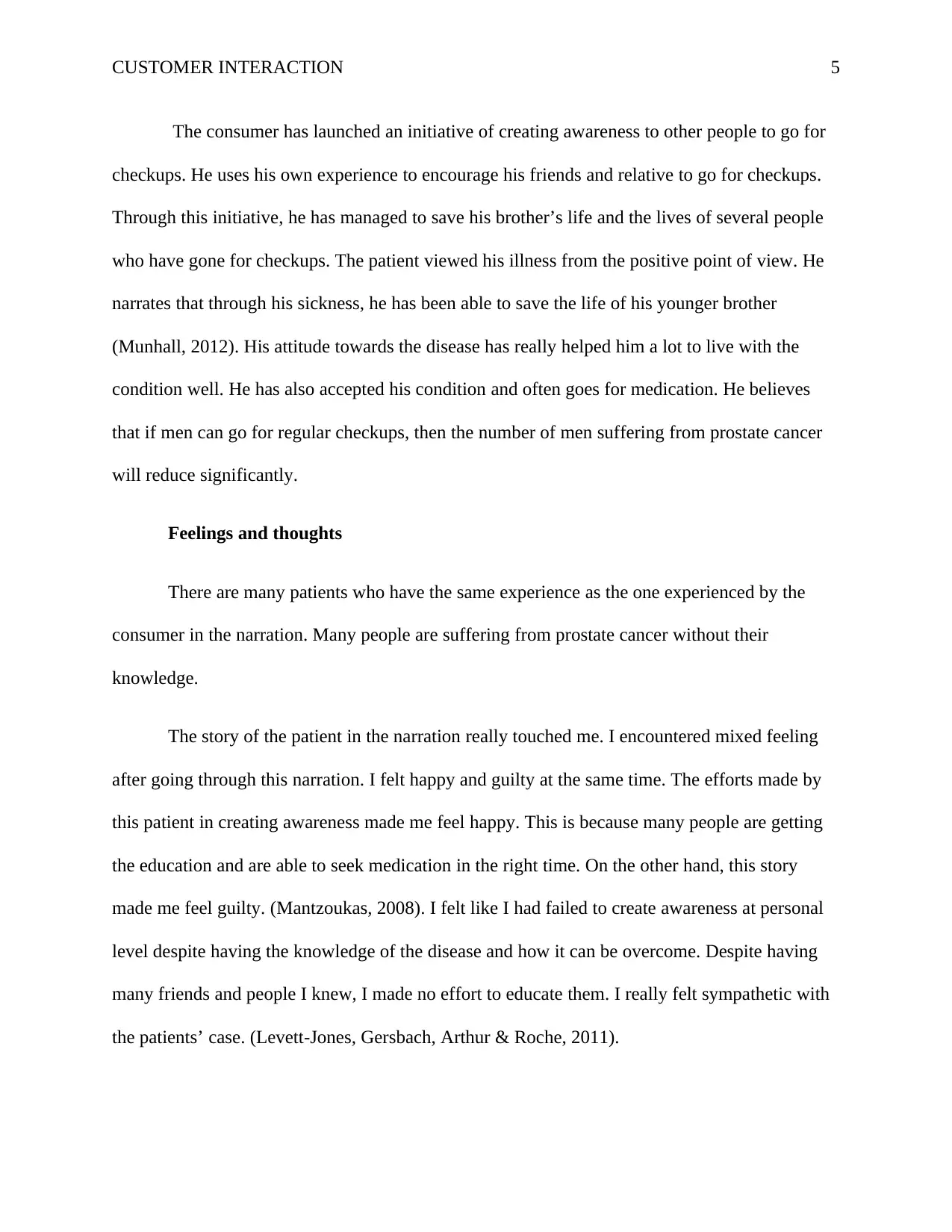
CUSTOMER INTERACTION 5
The consumer has launched an initiative of creating awareness to other people to go for
checkups. He uses his own experience to encourage his friends and relative to go for checkups.
Through this initiative, he has managed to save his brother’s life and the lives of several people
who have gone for checkups. The patient viewed his illness from the positive point of view. He
narrates that through his sickness, he has been able to save the life of his younger brother
(Munhall, 2012). His attitude towards the disease has really helped him a lot to live with the
condition well. He has also accepted his condition and often goes for medication. He believes
that if men can go for regular checkups, then the number of men suffering from prostate cancer
will reduce significantly.
Feelings and thoughts
There are many patients who have the same experience as the one experienced by the
consumer in the narration. Many people are suffering from prostate cancer without their
knowledge.
The story of the patient in the narration really touched me. I encountered mixed feeling
after going through this narration. I felt happy and guilty at the same time. The efforts made by
this patient in creating awareness made me feel happy. This is because many people are getting
the education and are able to seek medication in the right time. On the other hand, this story
made me feel guilty. (Mantzoukas, 2008). I felt like I had failed to create awareness at personal
level despite having the knowledge of the disease and how it can be overcome. Despite having
many friends and people I knew, I made no effort to educate them. I really felt sympathetic with
the patients’ case. (Levett-Jones, Gersbach, Arthur & Roche, 2011).
The consumer has launched an initiative of creating awareness to other people to go for
checkups. He uses his own experience to encourage his friends and relative to go for checkups.
Through this initiative, he has managed to save his brother’s life and the lives of several people
who have gone for checkups. The patient viewed his illness from the positive point of view. He
narrates that through his sickness, he has been able to save the life of his younger brother
(Munhall, 2012). His attitude towards the disease has really helped him a lot to live with the
condition well. He has also accepted his condition and often goes for medication. He believes
that if men can go for regular checkups, then the number of men suffering from prostate cancer
will reduce significantly.
Feelings and thoughts
There are many patients who have the same experience as the one experienced by the
consumer in the narration. Many people are suffering from prostate cancer without their
knowledge.
The story of the patient in the narration really touched me. I encountered mixed feeling
after going through this narration. I felt happy and guilty at the same time. The efforts made by
this patient in creating awareness made me feel happy. This is because many people are getting
the education and are able to seek medication in the right time. On the other hand, this story
made me feel guilty. (Mantzoukas, 2008). I felt like I had failed to create awareness at personal
level despite having the knowledge of the disease and how it can be overcome. Despite having
many friends and people I knew, I made no effort to educate them. I really felt sympathetic with
the patients’ case. (Levett-Jones, Gersbach, Arthur & Roche, 2011).
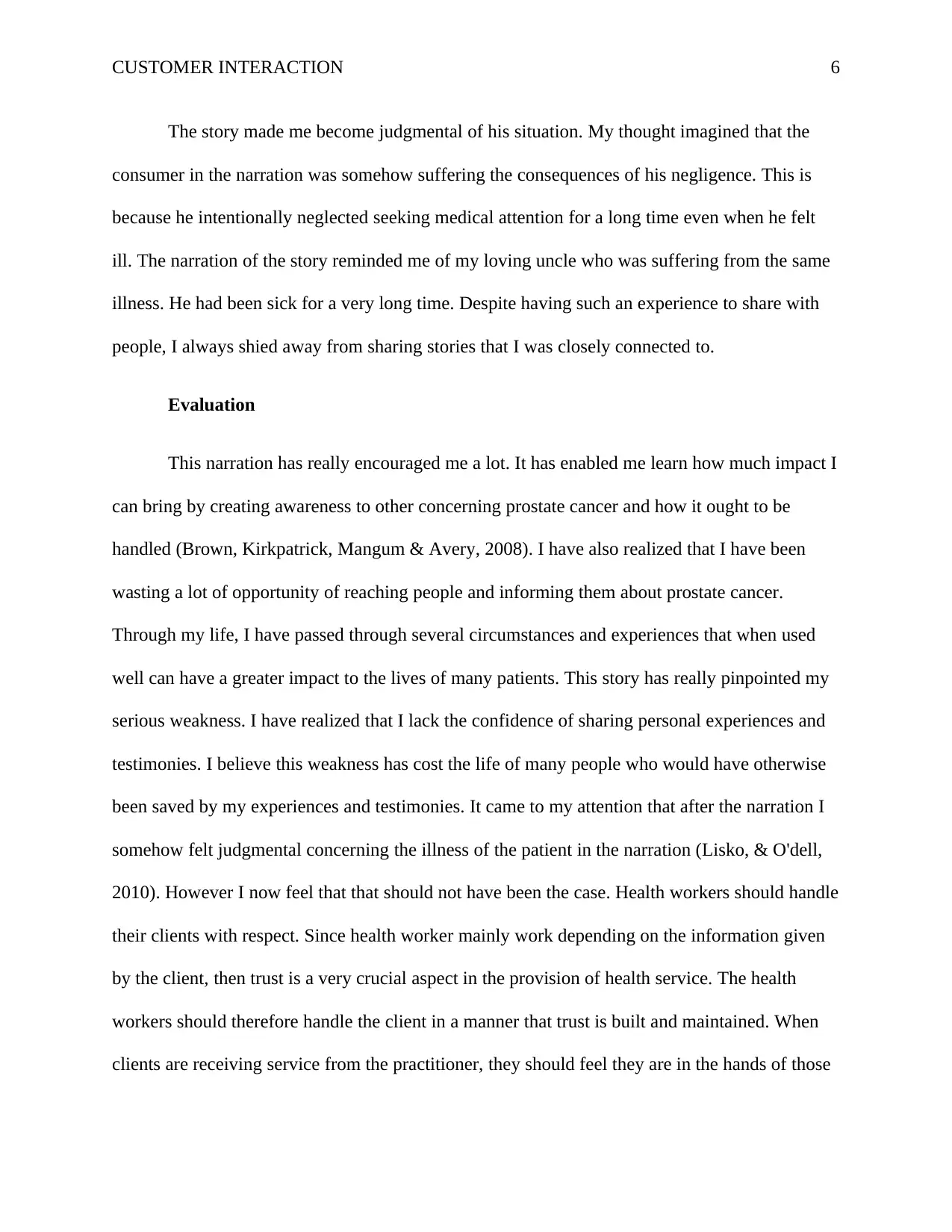
CUSTOMER INTERACTION 6
The story made me become judgmental of his situation. My thought imagined that the
consumer in the narration was somehow suffering the consequences of his negligence. This is
because he intentionally neglected seeking medical attention for a long time even when he felt
ill. The narration of the story reminded me of my loving uncle who was suffering from the same
illness. He had been sick for a very long time. Despite having such an experience to share with
people, I always shied away from sharing stories that I was closely connected to.
Evaluation
This narration has really encouraged me a lot. It has enabled me learn how much impact I
can bring by creating awareness to other concerning prostate cancer and how it ought to be
handled (Brown, Kirkpatrick, Mangum & Avery, 2008). I have also realized that I have been
wasting a lot of opportunity of reaching people and informing them about prostate cancer.
Through my life, I have passed through several circumstances and experiences that when used
well can have a greater impact to the lives of many patients. This story has really pinpointed my
serious weakness. I have realized that I lack the confidence of sharing personal experiences and
testimonies. I believe this weakness has cost the life of many people who would have otherwise
been saved by my experiences and testimonies. It came to my attention that after the narration I
somehow felt judgmental concerning the illness of the patient in the narration (Lisko, & O'dell,
2010). However I now feel that that should not have been the case. Health workers should handle
their clients with respect. Since health worker mainly work depending on the information given
by the client, then trust is a very crucial aspect in the provision of health service. The health
workers should therefore handle the client in a manner that trust is built and maintained. When
clients are receiving service from the practitioner, they should feel they are in the hands of those
The story made me become judgmental of his situation. My thought imagined that the
consumer in the narration was somehow suffering the consequences of his negligence. This is
because he intentionally neglected seeking medical attention for a long time even when he felt
ill. The narration of the story reminded me of my loving uncle who was suffering from the same
illness. He had been sick for a very long time. Despite having such an experience to share with
people, I always shied away from sharing stories that I was closely connected to.
Evaluation
This narration has really encouraged me a lot. It has enabled me learn how much impact I
can bring by creating awareness to other concerning prostate cancer and how it ought to be
handled (Brown, Kirkpatrick, Mangum & Avery, 2008). I have also realized that I have been
wasting a lot of opportunity of reaching people and informing them about prostate cancer.
Through my life, I have passed through several circumstances and experiences that when used
well can have a greater impact to the lives of many patients. This story has really pinpointed my
serious weakness. I have realized that I lack the confidence of sharing personal experiences and
testimonies. I believe this weakness has cost the life of many people who would have otherwise
been saved by my experiences and testimonies. It came to my attention that after the narration I
somehow felt judgmental concerning the illness of the patient in the narration (Lisko, & O'dell,
2010). However I now feel that that should not have been the case. Health workers should handle
their clients with respect. Since health worker mainly work depending on the information given
by the client, then trust is a very crucial aspect in the provision of health service. The health
workers should therefore handle the client in a manner that trust is built and maintained. When
clients are receiving service from the practitioner, they should feel they are in the hands of those
⊘ This is a preview!⊘
Do you want full access?
Subscribe today to unlock all pages.

Trusted by 1+ million students worldwide
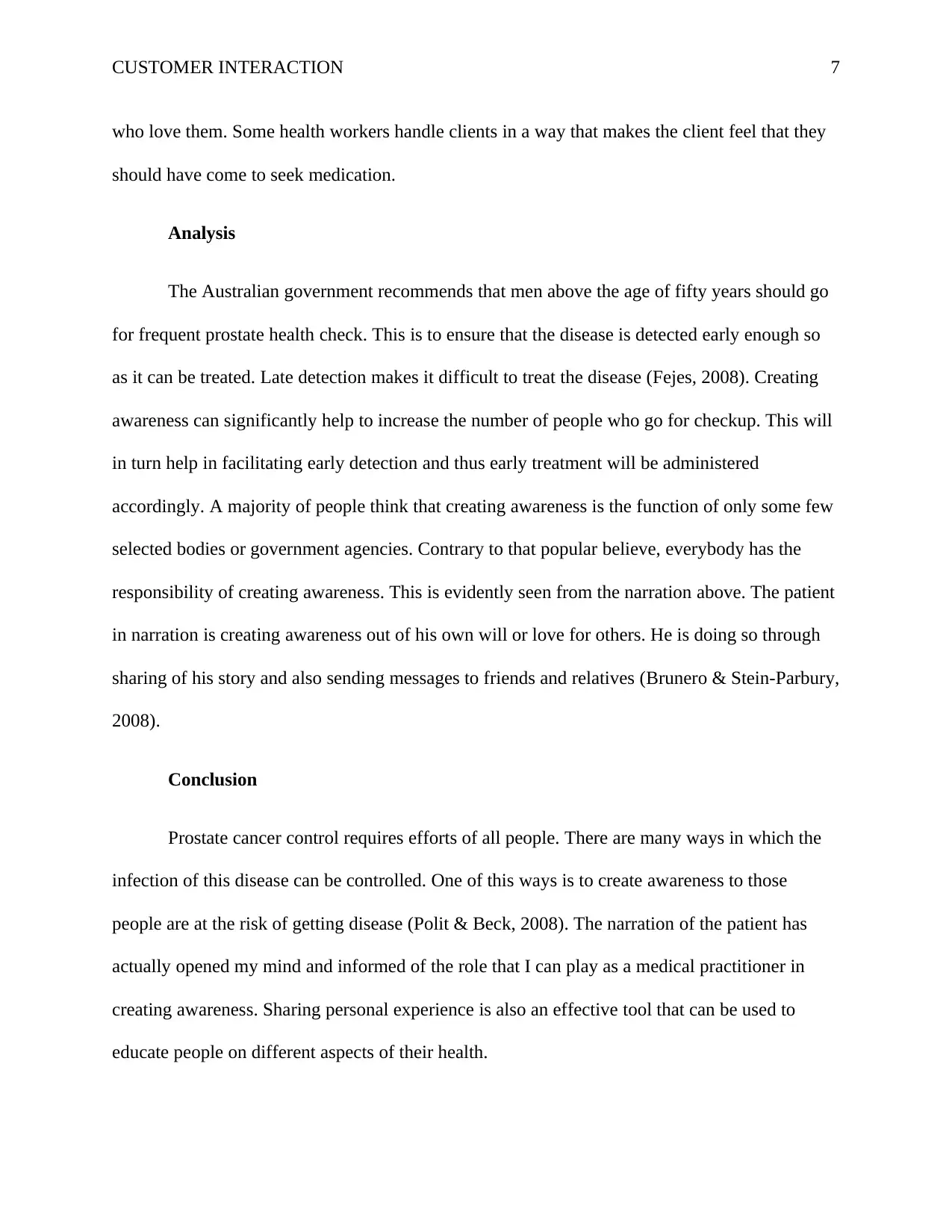
CUSTOMER INTERACTION 7
who love them. Some health workers handle clients in a way that makes the client feel that they
should have come to seek medication.
Analysis
The Australian government recommends that men above the age of fifty years should go
for frequent prostate health check. This is to ensure that the disease is detected early enough so
as it can be treated. Late detection makes it difficult to treat the disease (Fejes, 2008). Creating
awareness can significantly help to increase the number of people who go for checkup. This will
in turn help in facilitating early detection and thus early treatment will be administered
accordingly. A majority of people think that creating awareness is the function of only some few
selected bodies or government agencies. Contrary to that popular believe, everybody has the
responsibility of creating awareness. This is evidently seen from the narration above. The patient
in narration is creating awareness out of his own will or love for others. He is doing so through
sharing of his story and also sending messages to friends and relatives (Brunero & Stein-Parbury,
2008).
Conclusion
Prostate cancer control requires efforts of all people. There are many ways in which the
infection of this disease can be controlled. One of this ways is to create awareness to those
people are at the risk of getting disease (Polit & Beck, 2008). The narration of the patient has
actually opened my mind and informed of the role that I can play as a medical practitioner in
creating awareness. Sharing personal experience is also an effective tool that can be used to
educate people on different aspects of their health.
who love them. Some health workers handle clients in a way that makes the client feel that they
should have come to seek medication.
Analysis
The Australian government recommends that men above the age of fifty years should go
for frequent prostate health check. This is to ensure that the disease is detected early enough so
as it can be treated. Late detection makes it difficult to treat the disease (Fejes, 2008). Creating
awareness can significantly help to increase the number of people who go for checkup. This will
in turn help in facilitating early detection and thus early treatment will be administered
accordingly. A majority of people think that creating awareness is the function of only some few
selected bodies or government agencies. Contrary to that popular believe, everybody has the
responsibility of creating awareness. This is evidently seen from the narration above. The patient
in narration is creating awareness out of his own will or love for others. He is doing so through
sharing of his story and also sending messages to friends and relatives (Brunero & Stein-Parbury,
2008).
Conclusion
Prostate cancer control requires efforts of all people. There are many ways in which the
infection of this disease can be controlled. One of this ways is to create awareness to those
people are at the risk of getting disease (Polit & Beck, 2008). The narration of the patient has
actually opened my mind and informed of the role that I can play as a medical practitioner in
creating awareness. Sharing personal experience is also an effective tool that can be used to
educate people on different aspects of their health.
Paraphrase This Document
Need a fresh take? Get an instant paraphrase of this document with our AI Paraphraser
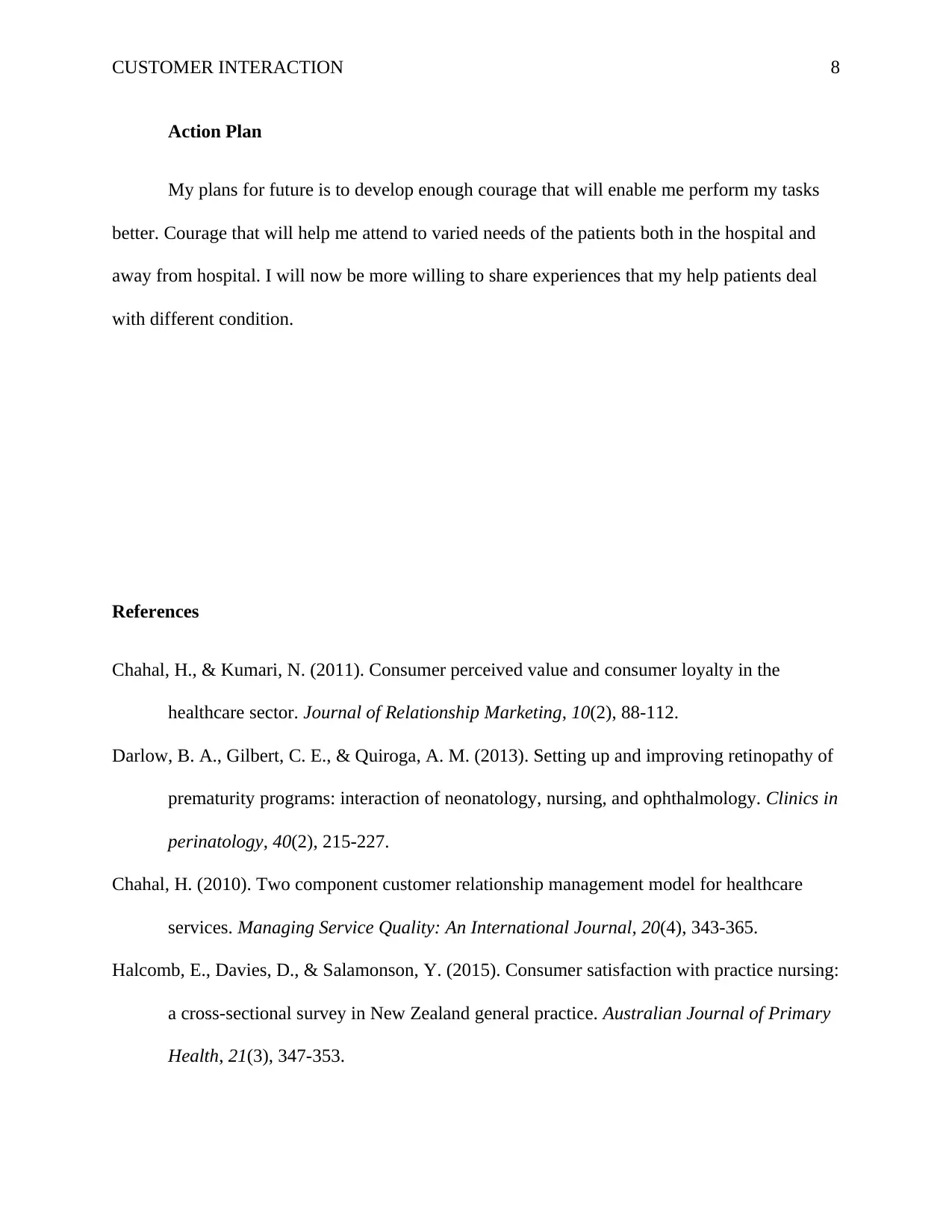
CUSTOMER INTERACTION 8
Action Plan
My plans for future is to develop enough courage that will enable me perform my tasks
better. Courage that will help me attend to varied needs of the patients both in the hospital and
away from hospital. I will now be more willing to share experiences that my help patients deal
with different condition.
References
Chahal, H., & Kumari, N. (2011). Consumer perceived value and consumer loyalty in the
healthcare sector. Journal of Relationship Marketing, 10(2), 88-112.
Darlow, B. A., Gilbert, C. E., & Quiroga, A. M. (2013). Setting up and improving retinopathy of
prematurity programs: interaction of neonatology, nursing, and ophthalmology. Clinics in
perinatology, 40(2), 215-227.
Chahal, H. (2010). Two component customer relationship management model for healthcare
services. Managing Service Quality: An International Journal, 20(4), 343-365.
Halcomb, E., Davies, D., & Salamonson, Y. (2015). Consumer satisfaction with practice nursing:
a cross-sectional survey in New Zealand general practice. Australian Journal of Primary
Health, 21(3), 347-353.
Action Plan
My plans for future is to develop enough courage that will enable me perform my tasks
better. Courage that will help me attend to varied needs of the patients both in the hospital and
away from hospital. I will now be more willing to share experiences that my help patients deal
with different condition.
References
Chahal, H., & Kumari, N. (2011). Consumer perceived value and consumer loyalty in the
healthcare sector. Journal of Relationship Marketing, 10(2), 88-112.
Darlow, B. A., Gilbert, C. E., & Quiroga, A. M. (2013). Setting up and improving retinopathy of
prematurity programs: interaction of neonatology, nursing, and ophthalmology. Clinics in
perinatology, 40(2), 215-227.
Chahal, H. (2010). Two component customer relationship management model for healthcare
services. Managing Service Quality: An International Journal, 20(4), 343-365.
Halcomb, E., Davies, D., & Salamonson, Y. (2015). Consumer satisfaction with practice nursing:
a cross-sectional survey in New Zealand general practice. Australian Journal of Primary
Health, 21(3), 347-353.
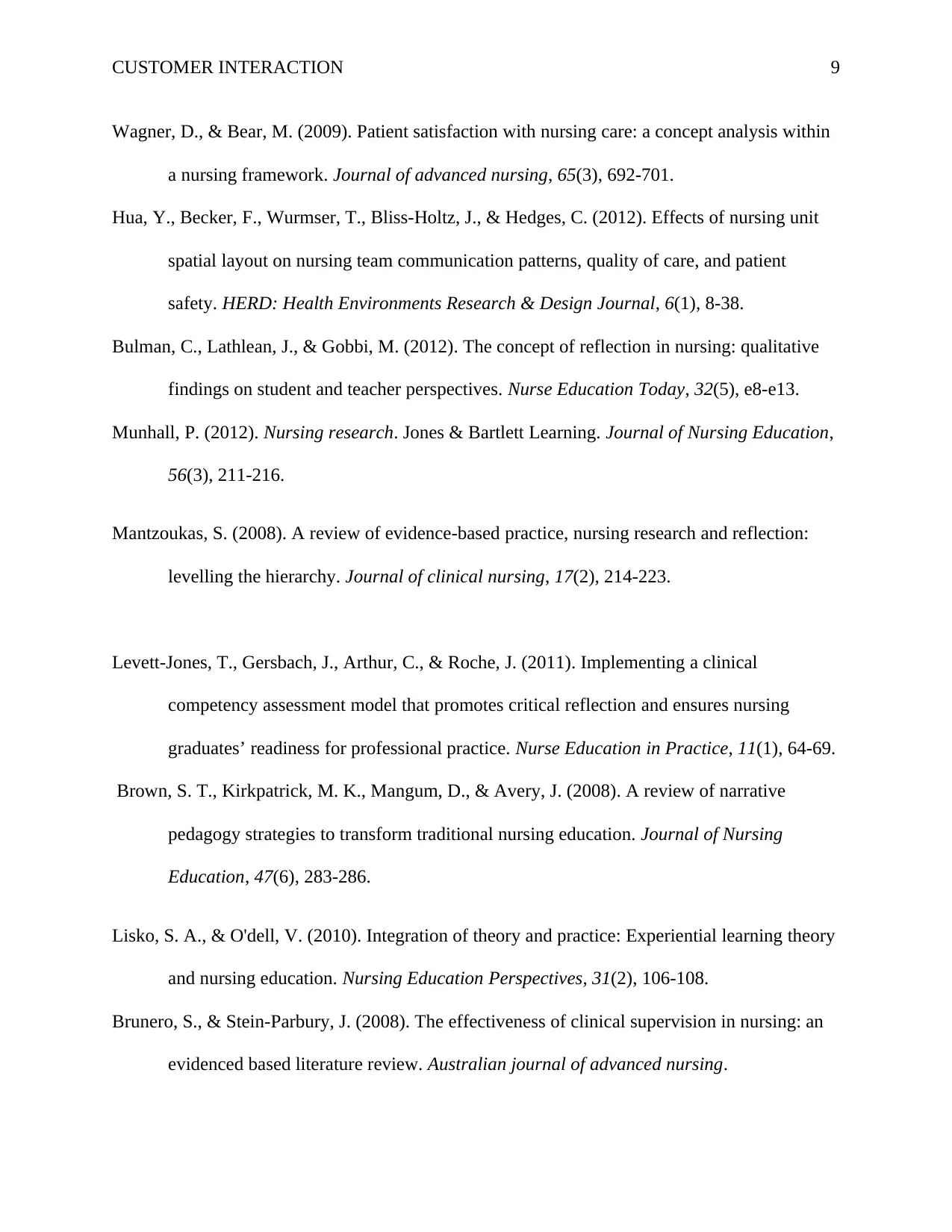
CUSTOMER INTERACTION 9
Wagner, D., & Bear, M. (2009). Patient satisfaction with nursing care: a concept analysis within
a nursing framework. Journal of advanced nursing, 65(3), 692-701.
Hua, Y., Becker, F., Wurmser, T., Bliss-Holtz, J., & Hedges, C. (2012). Effects of nursing unit
spatial layout on nursing team communication patterns, quality of care, and patient
safety. HERD: Health Environments Research & Design Journal, 6(1), 8-38.
Bulman, C., Lathlean, J., & Gobbi, M. (2012). The concept of reflection in nursing: qualitative
findings on student and teacher perspectives. Nurse Education Today, 32(5), e8-e13.
Munhall, P. (2012). Nursing research. Jones & Bartlett Learning. Journal of Nursing Education,
56(3), 211-216.
Mantzoukas, S. (2008). A review of evidence‐based practice, nursing research and reflection:
levelling the hierarchy. Journal of clinical nursing, 17(2), 214-223.
Levett-Jones, T., Gersbach, J., Arthur, C., & Roche, J. (2011). Implementing a clinical
competency assessment model that promotes critical reflection and ensures nursing
graduates’ readiness for professional practice. Nurse Education in Practice, 11(1), 64-69.
Brown, S. T., Kirkpatrick, M. K., Mangum, D., & Avery, J. (2008). A review of narrative
pedagogy strategies to transform traditional nursing education. Journal of Nursing
Education, 47(6), 283-286.
Lisko, S. A., & O'dell, V. (2010). Integration of theory and practice: Experiential learning theory
and nursing education. Nursing Education Perspectives, 31(2), 106-108.
Brunero, S., & Stein-Parbury, J. (2008). The effectiveness of clinical supervision in nursing: an
evidenced based literature review. Australian journal of advanced nursing.
Wagner, D., & Bear, M. (2009). Patient satisfaction with nursing care: a concept analysis within
a nursing framework. Journal of advanced nursing, 65(3), 692-701.
Hua, Y., Becker, F., Wurmser, T., Bliss-Holtz, J., & Hedges, C. (2012). Effects of nursing unit
spatial layout on nursing team communication patterns, quality of care, and patient
safety. HERD: Health Environments Research & Design Journal, 6(1), 8-38.
Bulman, C., Lathlean, J., & Gobbi, M. (2012). The concept of reflection in nursing: qualitative
findings on student and teacher perspectives. Nurse Education Today, 32(5), e8-e13.
Munhall, P. (2012). Nursing research. Jones & Bartlett Learning. Journal of Nursing Education,
56(3), 211-216.
Mantzoukas, S. (2008). A review of evidence‐based practice, nursing research and reflection:
levelling the hierarchy. Journal of clinical nursing, 17(2), 214-223.
Levett-Jones, T., Gersbach, J., Arthur, C., & Roche, J. (2011). Implementing a clinical
competency assessment model that promotes critical reflection and ensures nursing
graduates’ readiness for professional practice. Nurse Education in Practice, 11(1), 64-69.
Brown, S. T., Kirkpatrick, M. K., Mangum, D., & Avery, J. (2008). A review of narrative
pedagogy strategies to transform traditional nursing education. Journal of Nursing
Education, 47(6), 283-286.
Lisko, S. A., & O'dell, V. (2010). Integration of theory and practice: Experiential learning theory
and nursing education. Nursing Education Perspectives, 31(2), 106-108.
Brunero, S., & Stein-Parbury, J. (2008). The effectiveness of clinical supervision in nursing: an
evidenced based literature review. Australian journal of advanced nursing.
⊘ This is a preview!⊘
Do you want full access?
Subscribe today to unlock all pages.

Trusted by 1+ million students worldwide
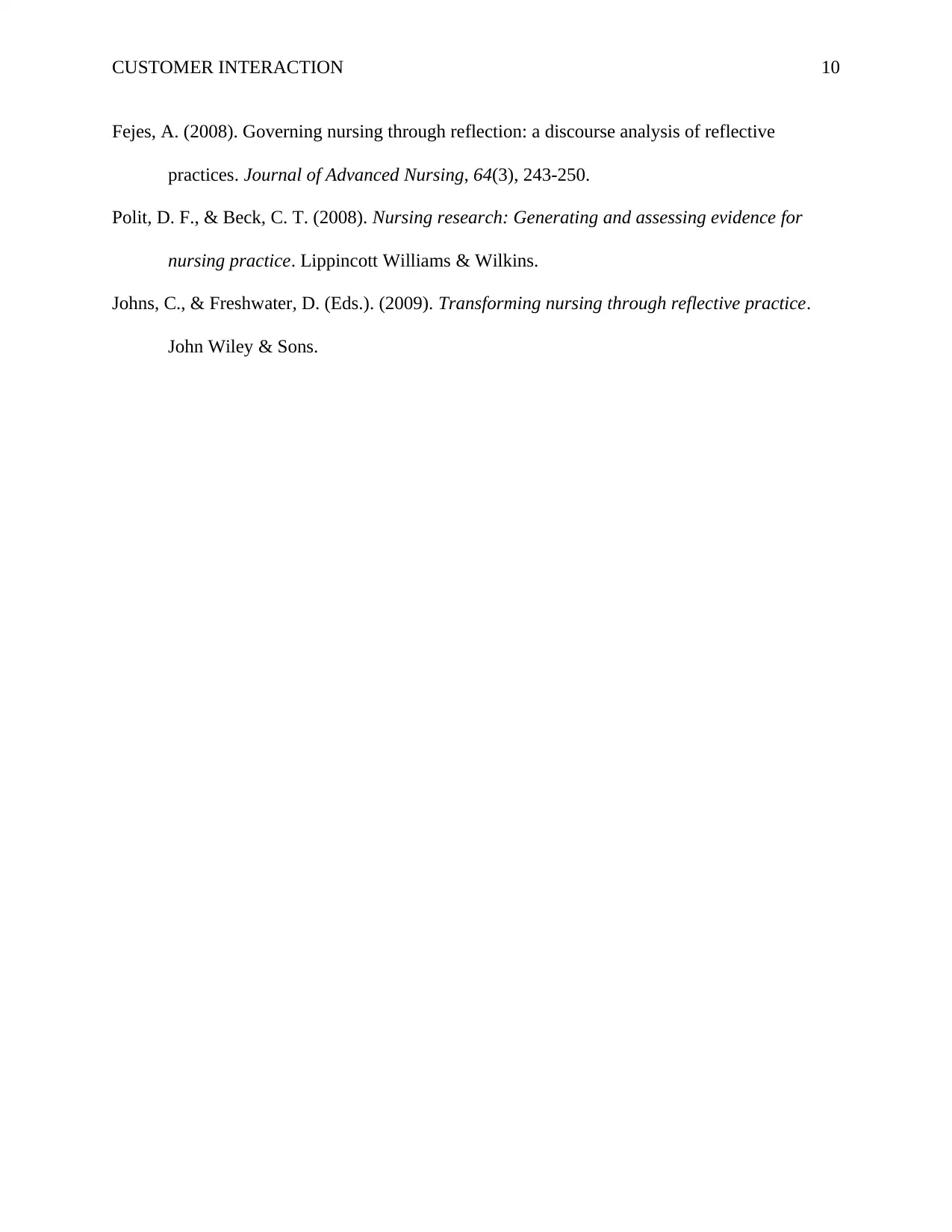
CUSTOMER INTERACTION 10
Fejes, A. (2008). Governing nursing through reflection: a discourse analysis of reflective
practices. Journal of Advanced Nursing, 64(3), 243-250.
Polit, D. F., & Beck, C. T. (2008). Nursing research: Generating and assessing evidence for
nursing practice. Lippincott Williams & Wilkins.
Johns, C., & Freshwater, D. (Eds.). (2009). Transforming nursing through reflective practice.
John Wiley & Sons.
Fejes, A. (2008). Governing nursing through reflection: a discourse analysis of reflective
practices. Journal of Advanced Nursing, 64(3), 243-250.
Polit, D. F., & Beck, C. T. (2008). Nursing research: Generating and assessing evidence for
nursing practice. Lippincott Williams & Wilkins.
Johns, C., & Freshwater, D. (Eds.). (2009). Transforming nursing through reflective practice.
John Wiley & Sons.
1 out of 10
Related Documents
Your All-in-One AI-Powered Toolkit for Academic Success.
+13062052269
info@desklib.com
Available 24*7 on WhatsApp / Email
![[object Object]](/_next/static/media/star-bottom.7253800d.svg)
Unlock your academic potential
Copyright © 2020–2025 A2Z Services. All Rights Reserved. Developed and managed by ZUCOL.

![Nursing Personal Statement for University Application - [Year]](/_next/image/?url=https%3A%2F%2Fdesklib.com%2Fmedia%2Fimages%2Ffs%2F8b9dc1d7da2e42a582d59123880456ac.jpg&w=256&q=75)



